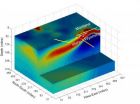(Press-News.org) The evolution and diversification of the more than 300,000 living species of flowering plants may have been "jump started" much earlier than previously calculated, a new study indicates. According to Claude dePamphilis, a professor of biology at Penn State University and the lead author of the study, which includes scientists at six universities, two major upheavals in the plant genome occurred hundreds of millions of years ago -- nearly 200 million years earlier than the events that other research groups had described. The research also indicates that these upheavals produced thousands of new genes that may have helped drive the evolutionary explosion that led to the rich diversity of present-day flowering plants. The study, which provides a wealth of new genetic data and a more precise evolutionary time scale, is expected to change the way biologists view the family trees of plants in general and flowering plants in particular. The research findings will be posted on the early-online website of the journal Nature on 10 April 2011, and later will be published in the journal.
"We began with some intense genomic detective work -- combing through nine previously sequenced plant genomes, plus millions of new gene sequences that the Ancestral Angiosperm Genome Project (http://ancangio.uga.edu/) had gathered from the earliest surviving lineages of flowering plants," dePamphilis said. "We knew that, at some point in ancient history, one or more important genetic metamorphoses had occurred in the ancestor of flowering plants, and we also knew that these metamorphoses could explain the enormous success of so many species living on the Earth today. Most importantly, we suspected that these important changes had been driven by a common mechanism instead of by many independent events." DePamphilis explained that, after examining volumes of molecular evidence, his team discovered and calculated the dates for two instances of a special kind of DNA mutation -- called a polyploidy event -- that revolutionized the flowering-plant lineage.
"A polyploidy event is basically the acquisition, through mutation, of a 'double dose' of genetic material," explained Yuannian Jiao, a graduate student at Penn State and the first author of the study. "In vertebrates, although genome duplication is known to occur, it generally is lethal. Plants, on the other hand, often survive and can sometimes benefit from duplicated genomes." Jiao explained that, over the generations, most duplicated genes from polyploidy events simply are lost. However, other genes adopt new functions or, in some instances, subdivide the workload with the genetic segments that were duplicated, thereby cultivating more efficiency and better specialization of tasks for the genome as a whole.
Jiao also explained that, although ancient events of polyploidy have been well documented in plant-genome-sequencing projects, biologists had dated the earliest polyploidy event in flowering plants at around 125 to 150 million years ago. "There were hints that even earlier events had occurred, but no good evidence," Jiao said. "That's what makes our team's findings so exciting. We identified at least two major events -- one occurring in the ancestor of all seed plants about 320 million years ago, and another occurring in the flowering-plant lineage specifically, about 192 to 210 million years ago. That's up to 200 million years earlier than such events were assumed to have taken place."
DePamphilis added that such polyploidy events probably set in motion a kind of genomic renaissance, and that present-day varieties now are reaping the rewards. "Thanks to events such as these, where vast stretches of DNA have been duplicated and added to the genome, flowering plants have been able to evolve new and better functions. They have seized on the opportunity to become so diverse, so exquisite, and so prevalent," dePamphilis said. He explained that his team was able to trace the history of some of the major genes that define how flowering plants work. "Some of these new genes led to true innovations and have become vital parts of the genetic toolkit for the regulation of flower development," he said. "In other words, without the genes that these polyploidy events helped to create, flowering plants as we know them today probably would not exist."
DePamphilis also said that, thanks to the two polyploidy events that his research team identified, flowering plants may have enjoyed a distinct evolutionary advantage that allowed them to survive harsh climate changes and even mass extinctions. One such extinction that was accompanied by more-recent polyploidy events in several flowering-plant groups was the Cretaceous–Tertiary extinction event (the K-T event) -- a mass extinction of animals and plants that occurred approximately 65.5 million years ago that may have been triggered by a massive asteroid impact.
"Ever since Charles Darwin so famously called the rapid diversification of flowering plants in the fossil record an 'abominable mystery,' generations of scientists have worked to solve this puzzle," dePamphilis said. "We used to say that most of the hundreds of thousands of successful species of flowering plants show genetic traces of ancient polyploidy events. The further we push back the date of when these events happened, the more confidently we can claim that, not most, but all flowering plants are the result of large-scale duplications of the genome. It's possible that the important polyploidy events we've identified were the equivalent of two 'big bangs' for flowering plants."
INFORMATION:
In addition to dePamphilis and Jiao, other researchers who contributed to the study include Norman J. Wickett, Lena Landherr, Paula E. Ralph, Lynn P. Tomsho, Yi Hu, Stephan C. Schuster, and Hong Ma from Penn State; Saravanaraj Ayyampalayam and Jim Leebens-Mack from the University of Georgia; André S. Chanderbali, Pamela S. Soltis, and Douglas E. Soltis from the University of Florida; Haiying Liang from Clemson University; Sandra W. Clifton from Washington University; and Scott E. Schlarbaum from the University of Tennessee.
The work was funded, primarily, by the National Science Foundation Plant Genome Research Program (the Ancestral Angiosperm Genome Project), and, in part, by the Penn State Department of Biology, the Huck Institutes of the Life Sciences at Penn State, and Fudan University in China.
CONTACTS
Claude dePamphilis: 814-321-2256, cwd3@psu.edu
Barbara Kennedy (PIO): 814-863-4682, science@psu.edu
IMAGES
High-resolution images associated with this research are online at http://www.science.psu.edu/news-and-events/2011-news/dePamphilis4-2011
CAPTIONS AND CREDITS
(from top to bottom on page http://www.science.psu.edu/news-and-events/2011-news/dePamphilis4-2011)
Image #1: Amborella trichopoda, a flowering plant. Amborella trichopoda is a basal angiosperm and the earliest surviving branch of the angiosperm tree of life. This plant was included in the Ancestral Angiosperm Genome Project.
Image #2: Ancient polyploidy events of genome duplication may have helped flowering plants evolve and become more diverse.
Image #3: Yellow water lily (Nuphar advena), a basal angiosperm included in the study led by Claude dePamphilis. This plant was included in the Ancestral Angiosperm Genome Project.
Image #4: Yellow poplar tree (Liriodendron tulipifera), a basal angiosperm included in the study led by Claude dePamphilis. This plant was included in the Ancestral Angiosperm Genome Project.
New genetic study helps to solve Darwin's mystery about the ancient evolution of flowering plants
2011-04-11
ELSE PRESS RELEASES FROM THIS DATE:
Experimental drug achieves unprecedented weight loss
2011-04-11
DURHAM, N.C.— An investigational combination of drugs already approved to treat obesity, migraine and epilepsy produced up to a 10 percent weight loss in obese individuals participating in a one-year clinical trial, according to researchers at Duke University Medical Center.
Appearing online in The Lancet today, the study found that treatment with the controlled-release combination therapy consisting of phentermine and topiramate also achieved significant reductions in blood pressure and hemoglobin A1C. Study participants also experienced improvements in cholesterol, ...
West Antarctic warming triggered by warmer sea surface in tropical Pacific
2011-04-11
The Antarctic Peninsula has warmed rapidly for the last half-century or more, and recent studies have shown that an adjacent area, continental West Antarctica, has steadily warmed for at least 30 years, but scientists haven't been sure why.
New University of Washington research shows that rising sea surface temperatures in the area of the Pacific Ocean along the equator and near the International Date Line drive atmospheric circulation that has caused some of the largest shifts in Antarctic climate in recent decades.
The warmer water generates rising air that creates ...
Big picture of how interferon-induced genes launch antiviral defenses revealed
2011-04-11
When viruses attack, one molecule more than any other fights back. Interferon triggers the activation of more than 350 genes, and despite the obvious connection, the vast majority have never been tested for antiviral properties. A team of researchers, led by scientists from Rockefeller University, for the first time has carried out a comprehensive, systematic evaluation of the antiviral activity of interferon-induced factors. The findings, published online today in the journal Nature, are a first step toward unraveling how these naturally occurring molecules work to inhibit ...
Electric Yellowstone
2011-04-11
SALT LAKE CITY, April 11, 2011 – University of Utah geophysicists made the first large-scale picture of the electrical conductivity of the gigantic underground plume of hot and partly molten rock that feeds the Yellowstone supervolcano. The image suggests the plume is even bigger than it appears in earlier images made with earthquake waves.
"It's like comparing ultrasound and MRI in the human body; they are different imaging technologies," says geophysics Professor Michael Zhdanov, principal author of the new study and an expert on measuring magnetic and electrical ...
Sleep issues contribute to cognitive problems in childhood cancer survivors
2011-04-11
A new analysis has found that childhood cancer survivors often suffer from sleep problems and fatigue, which negatively impact their attention and memory. Published early online in Cancer, a peer-reviewed journal of the American Cancer Society, the study indicates that addressing sleep hygiene among survivors of childhood cancer may help to improve their cognitive health.
Cognitive problems, such as trouble with attention and memory, often arise in survivors of childhood cancer. These problems, which are either a direct or indirect result of treatment, negatively impact ...
Immunization not linked to increased hospitalization for children with inherited disorder
2011-04-11
Children with inborn errors of metabolism received vaccines on the same immunization schedule as did healthy infants, according to Kaiser Permanente Vaccine Study Center scientists who examined the Kaiser Permanente Northern California population. In addition, immunization was not associated with significant increases in emergency room visits or hospitalizations during the month following vaccination, according to Nicola Klein, MD, PhD, lead author of the study and co-director of the Kaiser Permanente Vaccine Study Center.
The study appears in the current online issue ...
Bingo Liner Cruises in With Online Bingo Games
2011-04-11
Bingo Liner recently introduced a great new addition to their fun and exciting bingo games by adding an 'invite a friend' feature. Now, whenever a current Bingo Liner user invites a friend to join, they get GBP10 for free! As soon as the friend makes their first deposit, GBP10 immediately goes into their 128-bit encrypted account which has multiple firewalls, built to secure your account and protect your privacy.
This is just one of the features that Bingo Liner offers to keep the fun of online bingo going. This combines with their reload bonus offer, a 100% deposit ...
New review suggests drinking 100 percent fruit juice may offer disease-fighting benefits
2011-04-11
WASHINGTON, DC (April 11, 2011) – Drinking 100 percent fruit juices could have protective health benefits similar to those of whole fruits, according to research presented in a literature review yesterday at the 2011 Experimental Biology (EB) meeting.
Highlights from a new report summarizing recent research on the potential benefits of fruit juice suggest a positive association between intake of 100 percent juice and reduced risk for several chronic diseases, including cancer, markers for cardiovascular disease and cognitive decline.
"While it is universally accepted ...
Swingers Show Support for SwingLifeStyle on Facebook
2011-04-11
What began as a closed door and a "do not tell" in the swingers realm has recently become a popular trendy event. Swinging started out in the early war era when air force pilots would swap their wives. Some attribute the first type of these swinging events even further back to the time of the Romans. Since the Internet boom in the late 90s sites like SwingLifeStyle have given an all access place to meet and date swinger couples with a directory of swinger clubs across the US.
When the social site boom happened a few years back, most companies and websites were left in ...
PacketMicro and HSDC Announce Flexible Probing Systems for Large PCBs
2011-04-11
PacketMicro and High Speed Design Center (HSDC) announce today that they are offering the "Flex Probing System" family for testing large printed circuit boards (PCB). Comprising of Flex Positioners, Flex Scopes, and Flex Bridges, this system can typically be configured for either horizontal or vertical probing of large PCB in less than 10 minutes.
"The unique, stackable structure makes our Flex Probing System the perfect solution for testing the PCB system in a vertical probing configuration," said Ben Chia, HSDC President. "With the 2 mega-pixel Flex Scope and the ...


